Patient safety is a primary concern for gastrointestinal endoscopists. You may have recently heard or read about the spread of infection of difficult bacteria, called CRE, through a procedure called ERCP. The following information provides background information and explains important concepts.
What is ERCP?
ERCP stands for endoscopic retrograde cholangiopancreatography. It is an advanced highly technical endoscopic procedure.
The vast majority of people will never have an ERCP. For patients who do need it, ERCP is a critical and potentially life-saving procedure.
ERCP is performed using a special device called a duodenoscope. The duodenoscope is different from what is used in routine upper endoscopy or colonoscopy.
ERCP allows gastrointestinal endoscopists to diagnose and treat problems in the bile ducts and pancreatic ducts such as stones, narrowing (called strictures) and even complete blockages of a duct. The bile ducts and pancreatic ducts are the channels that carry fluids from the liver and pancreas to the intestine.
Before an ERCP, the gastrointestinal endoscopist will discuss the benefits and risks of this procedure with the patient and/or family members.
What is CRE bacteria?
CRE stands for Carbapenem-Resistant Enterobacteriaceae (CRE). Some have referred to this germ as a “superbug” because it has become resistant to most available antibiotics. CRE is a challenge for all specialties of medicine, including gastroenterology.
How common is infection by CRE bacteria through ERCP?
It is estimated that more than 500,000 ERCPs are performed each year in the US. From what we know, over the past few years, there have been fewer than 100 known cases of transmission of these problematic bacteria through ERCP.
In general, the infectious complication rate for ERCP overall is in total only about 1 percent, but that includes all types of bacteria and these few CRE cases do not change the overall risk.
How did CRE bacteria spread in these few cases?
As mentioned, ERCP is a highly advanced procedure that requires a specialized device called a duodenoscope. At this point, it is believed that the complex design of the duodenoscope may present a challenge for high-level disinfection of the device.
What we do know is that, when manufacturers’ guidelines for cleaning duodenoscopes are followed, the risk of transmission is extremely low. Of course, all procedures carry infection risks.
It is important to note that there have been no known cases of transmission of CRE bacteria with endoscopes used in routine endoscopy, such as colonoscopy.
What is being done to improve patient safety?
Patient safety is always our number one concern. This is an important issue for gastrointestinal experts. We share the public’s concerns.
First, we have made gastroenterologists and surgeons who perform ERCP aware of the potential for infection by CRE bacteria through ERCP. Second, we have urged increased vigilance around cleaning these highly specialized instruments and strict adherence to manufacturers’ guidelines and infection control guidelines.
We have also encouraged hospitals and other facilities to conduct periodic assessments of their disinfection procedures and practices. Additionally, we have urged these facilities to ensure the competency of all staff involved in disinfecting these devices.
Unfortunately, simple answers are not readily available. The gastroenterology societies continue to work with the Centers for Disease Control (CDC), the Food and Drug Administration (FDA), manufacturers and other groups to evaluate and address this complex issue.
###
About the American Society for Gastrointestinal Endoscopy
Since its founding in 1941, the American Society for Gastrointestinal Endoscopy (ASGE) has been dedicated to advancing patient care and digestive health by promoting excellence and innovation in gastrointestinal endoscopy. ASGE, with more than 13,000 members worldwide, promotes the highest standards for endoscopic training and practice, fosters endoscopic research, recognizes distinguished contributions to endoscopy, and is the foremost resource for endoscopic education. Visit www.asge.org for more information and to find a qualified doctor in your area.
About the AGA Institute
The American Gastroenterological Association is the trusted voice of the GI community. Founded in 1897, the AGA has grown to include 17,000 members from around the globe who are involved in all aspects of the science, practice and advancement of gastroenterology. The AGA Institute administers the practice, research and educational programs of the organization. www.gastro.org.
About the American College of Gastroenterology
Founded in 1932, the American College of Gastroenterology (ACG) is an organization with an international membership of more than 12,000 individuals from 80 countries. The College is committed to serving the clinically oriented digestive disease specialist through its emphasis on scholarly practice, teaching and research. The mission of the College is to serve the evolving needs of physicians in the delivery of high quality, scientifically sound, humanistic, ethical, and cost-effective health care to gastroenterology patients. www.gi.org.
About the American Association for the Study of Liver Diseases
AASLD is the leading organization of scientists and healthcare professionals committed to preventing and curing liver disease. AASLD was founded in 1950 by a small group of leading liver specialists and has grown to an international society responsible for all aspects of hepatology. Information about AASLD is available at www.aasld.org.
About SAGES
The mission of the Society of American Gastrointestinal and Endoscopic Surgeons is to improve quality patient care through education, research, innovation and leadership, principally in gastrointestinal and endoscopic surgery. SAGES was founded in 1981 and represents over 6000 surgeons worldwide. www.sages.org
Contacts:
| Jennifer Michalek ASGE 630-570-5632 jmichalek@asge.org |
Jessica Duncan AGA Institute 301-654-2055, ext 625 phone media@gastro.org |
Greg Bologna AASLD 703-299-9766 gbologna@aasld.org |
| Jacqueline Gaulin ACG 301-263-9000 mediaonly@gi.org |
Mary Cohen SAGES 310-437-0544 mary@sages.org |

 SAGES Fundamentals of Laparoscopic Surgery (FLS) Opens Two International Test Centers in France and Saudi Arabia
SAGES Fundamentals of Laparoscopic Surgery (FLS) Opens Two International Test Centers in France and Saudi Arabia